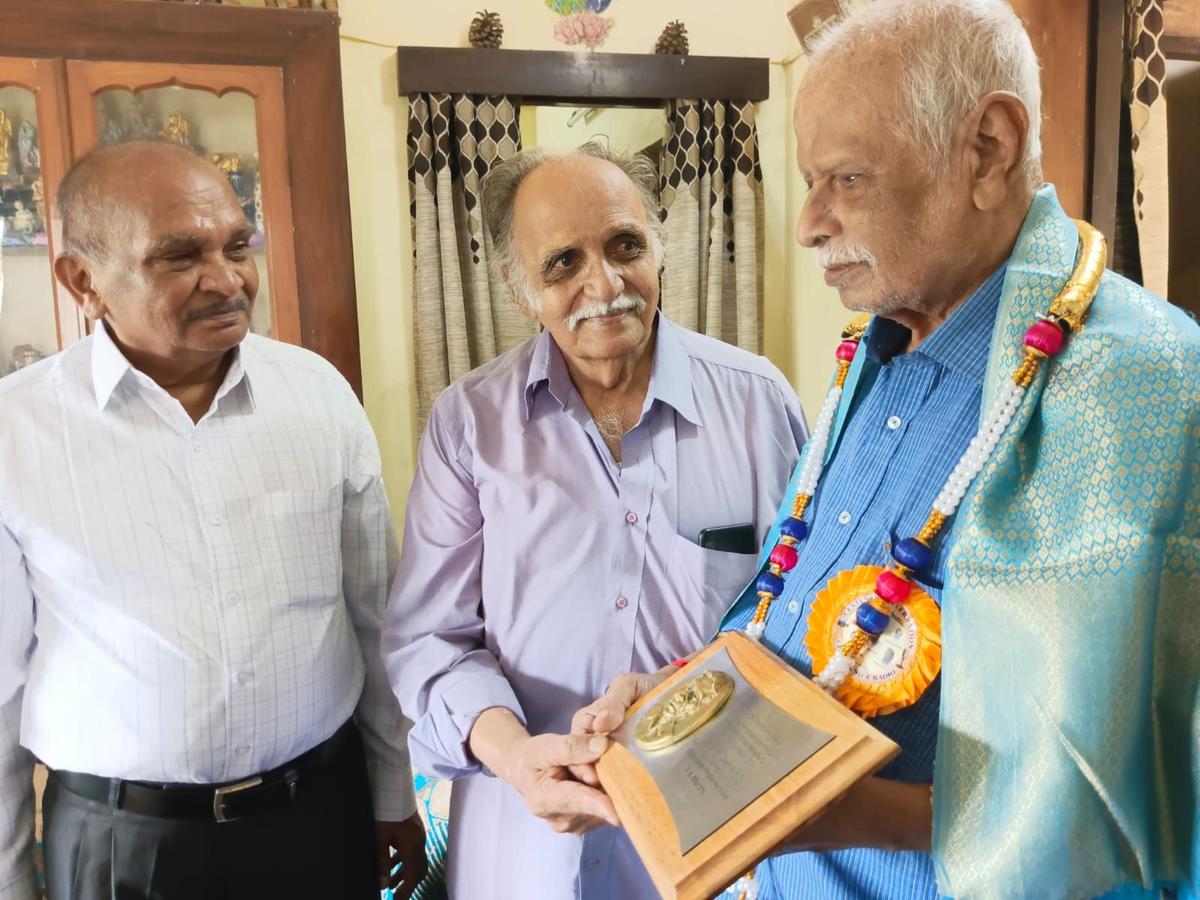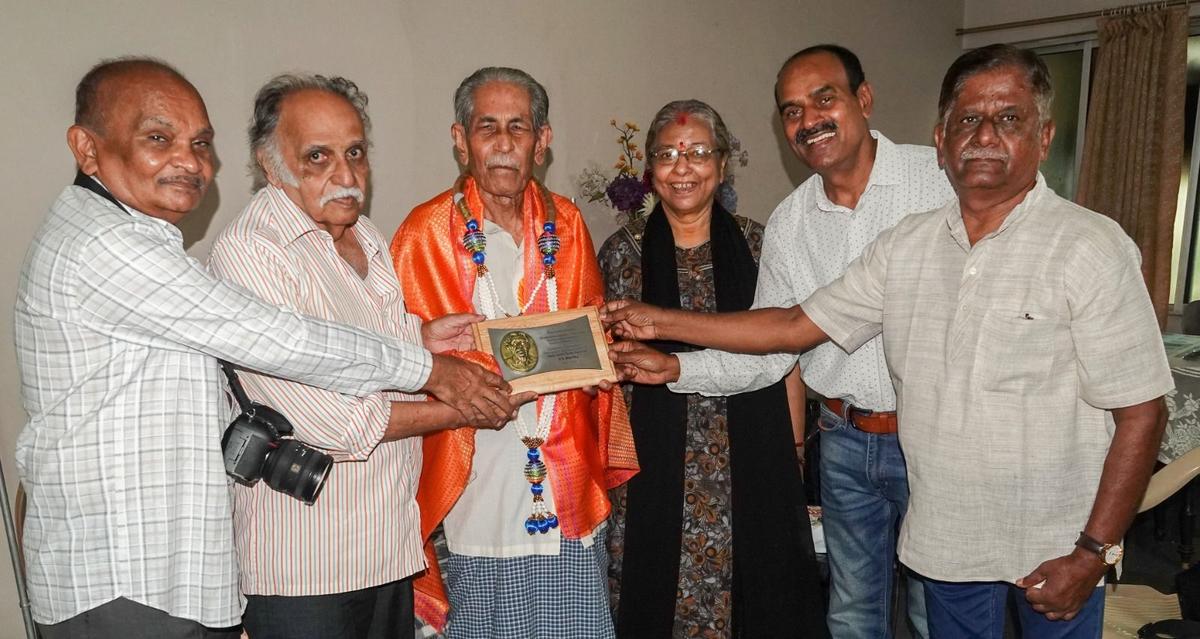A message from former alumni VK Murthy and SJ Polytechnic
November 2023 marks the centenary celebrations of cinematographer VK Murthy. As part of the year-long celebration, senior students of SJ Polytechnic College, Bangalore, led by veteran cinematographer, BS Basavaraj, felicitated three cinematographers – Dilip Dutta, Srinivas Mahapatra and Ghanshyam Mahapatra.
The three cinematographers were students of one of the first few batches of SJP. Ghanshyam was awarded the Jayadeva Award for his contribution to Odia cinema.
Basavaraj, who has worked with directors including Puttana Kanagal, said, “Our seniors have contributed immensely to cinema. As we are all alumni of SJP, we wanted to congratulate them.”
A group of former alumni traveled to Odisha as Ghanshyam and Srinivas are based there. Dileep joined the team from Mumbai. Basavaraj, who is a Rajyotsava awardee from SJP’s 1980 batch, says, “At SJP, they taught us cinematography, direction and script writing. We learned every aspect of filmmaking. Similarly, says Basavaraj, a student of photography will be taught printing and editing. “We even had a film appreciation course so we would be well versed in everything related to cinema.”
Dileep, says Basavaraj, joined Filmistan Studios in Mumbai as an associate director like VK Murthy, who moved to Mumbai from Mysuru. “Moorthy worked in only one Kannada film, Huuuuuuuuuuuuuuuuuuuuuuuuuuuuuuu (1993), directed by Rajendra Singh Babu, though his contribution to Hindi cinema is extensive.
That’s because in those days, says Basavaraj, cinematographers were hired by studios and paid monthly. “Moorthy was tied up with Guru Dutt’s production house and worked with him extensively. The situation changed after 1980, when working in a film was contractual.
Earlier, Basavaraj said, everyone from lead actors to cinematographers and music directors were employed at the studio. “Earlier it used to take at least two to three years to complete a film. Mughal-i-Azam It took more than 10 years to complete.”
In Chennai too, says Basavaraj, films were produced by studios like AVM or Gemini. “Today, if you have money, you can be an independent filmmaker and choose your crew and actors.”
Murthy was a student in the first batch of students at SJP, Basavaraj said. “Srinivasa belonged to the 1961 batch, moved to Mumbai to work in Hindi and Oriya feature films as well as documentaries. Srinivas has worked with stars and actors including Mala Sinha, Meena Kumari, Saira Banu, Sharmila Tagore, Neetu Singh, Shabana Azmi, Jai Mukherjee, Rajesh Khanna, Sunil Dutt, Raj Kapoor, Shammi Kapoor, Shashi Kapoor and Dharmendra.

Dilip Dutt receiving the special VK Murthy memorial Photo credit: Special Arrangements
Celebrating VK Murthy’s centenary, Basavaraj said, was an opportunity to meet their seniors. “Srinivasa was most passionate. Dileep, a 1963 batch, moved to Mumbai and worked in Hindi, Bhojpuri, Marathi, Oriya films. He has produced documentaries for the Government of Odisha and the Film Department of India.
Dileep is still working in Mumbai and his sons have also become cinematographers, says Basavaraj. “Small C Mulakat, Bazaar, Platform, Bazigar, And Up comes out Some of the films he has worked on. Dileep is in his 90s and plans to visit SJP and revisit his hostel rooms and classrooms as he says he has fond memories of the place.”
Worked in documentaries with Dileep The weavers of Sambalpur, a crop produced by storing a grain And Wood Carvings of Orissawhich was released through Film Division. S Visveswarappa, photographer of Chief Ministers from Deve Gowda to Baswaraj Bommai, is also a senior student of SJP. “When I wanted to study photography at SJP, my friends and family were skeptical. When I came to SJP, I discovered how vast the world of creativity is. When I wasn’t working in film, I took photography seriously.
It seemed appropriate to felicitate the veterans, says Visveswarappa. “When we studied at SJP, it was all theory. The real lesson was when we were on the field. They have achieved a lot with these limitations and it is an honor for us to be associated with the same college as them.”

Srinivas Mohapatra with SJP alumni Photo credit: Special Arrangements
Ramasagar Nanjunda Sivarama Reddy, also an alumnus of SJP, studied cinematography. “Govinda Nihalani and Basavaraj were my seniors. I am impressed with what Ghanshyam has achieved. He was in the SJP from 1955 to 1958. He came from Odisha because SJP was considered a pioneer in film studies in those days.” Despite Ghanshyam’s acclaim in Hindi films, Reddy says, Ghanshyam decided to set up base in Odisha and make films that promote Oriya culture. “He made films for the health department and started a production house – Konark Films Pvt Ltd in 1960.”
Ghanshyam is technically strong in every aspect of filmmaking, says Reddy. “This has been possible thanks to our training at SJP. He is 95 years old and still active in cinema. In 1962, he produced a documentary called Ma Aur Shisu for the Orissa Health Department, which won the Best Documentary Award from the Government of Odisha in 1975. He later became a member of the All India Panel of The Film Division-Mumbai.”
Ghanshyam Kelucharan made a documentary on Mahapatra and Sanjukta Panigrahi Odisha Dance, Reddy said. “It was the first film made in Eastmancollar and was screened in 1972 at the Fifth World Film Festival in New Delhi organized by the Film Society of India and the Department of Culture of the then USSR.”
has been published – October 15, 2024 12:21 pm IST



